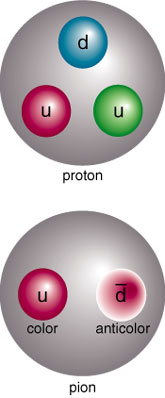|
Baryon Spectroscopy
|
The proton and neutron are the fundamental building blocks of the cores of atoms.
However, they themselves are composed of more fundamental constituents, quarks and
gluons. These interact via quantum chromodynamics (QCD) and are confined inside
their parent proton or neutron. However, not only are there protons and neutrons,
but the quarks can be excited to higher levels. These excited states result in
other particles, collectively known as baryons (three quarks). While most of these
excited particles are very shot lived, they can be observed by experiments looking at
their decay back to lighter baryons.
|

|
|
In a simple picture where the baryons are composed of three quarks (the so-called
quark models), theoretical predictions can be made about the expected spectrum
of baryons. However, after years of experimental study many of these expected
states have not been observed. However, one can build models in which the quarks
do not behave independently inside the nucleon, but rather act in a highly correlated
fashion--e.g two quarks acting like one object. In such models, the observed spectrum
can be reporuduced. However, other possible explanations for the so-called missing
baryons could be that the channels into which they decay have not been looked at
experimentally. We have set up an experimental program to carry this out by studing
a series of photo-production reactions listed below. The data for these come from the
CLAS experiment at
Jefferson Lab.
Our analysis of &omega photoproduction shows hints of both spin (3/2)+ and
(5/2)+ baryons that may be some of the missing states.
|
γ p → π+π- p |
Matt Bellis |
| γ p → η p |
Ph.D. Thesis Zeb Krahn (2007) |
| γ p → ω p |
Ph.D. Thesis Mike Williams (2007) |
| γ p → η ' p |
Ph.D. Thesis Zeb Krahn (2007) |
| γ p → K+ Λ |
Ph.D. Thesis Mike McCracken (2008) |
| γ p → K+ Σ0 |
Ph.D. Thesis Biplab Dey (2011) |
| γ p → φ p |
Ph.D. Thesis Biplab Dey (2011) |
| γpolarized p → ω p |
Ph.D. Thesis Brian Vernarsky (2014) |
| γ p → Λ(1520) K+ |
Ph.D. Thesis Will Levine (2016) |
|
|
|
|